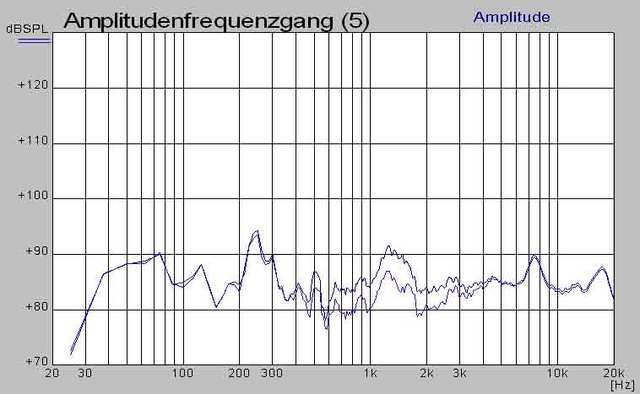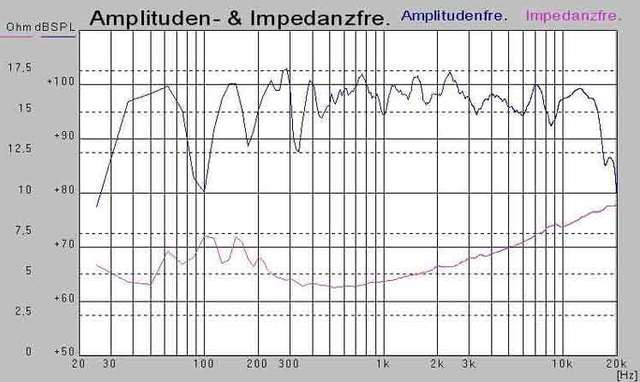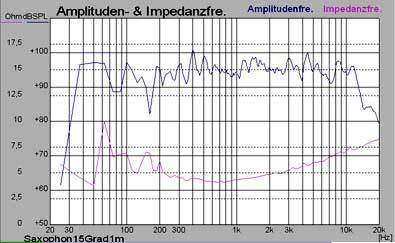I'm afraid not. Mass affects efficiency, but it does not impact on transient response. Transient response is inherently linked to bandwidth covered & the acceleration of the powertrain is proportional only to the amount of current in the voicecoil. The equation B*L*i / Mms clearly demonstrates this, where B = magnetic strength in the Vc gap, L = length of the VC in the VC gap, i = current in the VC, and Mms = moving mass of the powertrain (all in SI units, naturally). Dan Wiggins's did a short writeup on the subject a few years ago: http://www.adireaudio.com/Files/WooferSpeed.pdf
Well, sort of. I got hammered the last time this subject came up, but I remain unrepentant. If you do the dimensional analysis, BLi/Mms has the units of 1/s^2, which is close to accereation. Acceleration, of course, is m/s^2. The problem with the quoted discussion is that it assumes BL/Mms is constant. That s fine for any given driver, but not applicable as a comparison fo different drivers, which is the relevant point of the original discussion -- comparing drivers of different sizes. Different drivers will have different BL and Mms. Therefore, either BLi/Ms or BL/Mms should be an index of a drivers "speed", sort of.
Bob
You can get pretty low (and with finesse) with some of the FRs in this size (the CSS EL70 is a real stunner in this department), but they just can;t move the air needed for lots of impact. Besides, freeing the FR of low bass, gives big imprvements in mirange & HF finese.
dave
True. It can play bass well, but as Dave says it can't move enough air to get the right impact. But i guess no 4" will do that unless it has 2km excursion
bass by 4"
"but as Dave says it can't move enough air to get the right impact. But i guess no 4" will do"
hello,
thats not true by the right enclosure, look the double horn KORNETT
with two 4-5" driver 34 Hz with unbelievable "impact", translate the feedback
all write "unbelievable bass for the driver size"
kornett FB göö-- translate helps

"but as Dave says it can't move enough air to get the right impact. But i guess no 4" will do"
hello,
thats not true by the right enclosure, look the double horn KORNETT
with two 4-5" driver 34 Hz with unbelievable "impact", translate the feedback
all write "unbelievable bass for the driver size"
kornett FB göö-- translate helps

Therefore, either BLi/Ms or BL/Mms should be an index of a drivers "speed", sort of.
It's Bl/(Sqrt(Re)*Mms), since what you feed the driver with is voltage, not current. Otherwise you would overestimate the suitability for horns of a 16 Ohm driver and underestimate it for a 4 Ohm driver in comparison with 8 Ohm drivers.
Well, sort of. I got hammered the last time this subject came up, but I remain unrepentant. If you do the dimensional analysis, BLi/Mms has the units of 1/s^2, which is close to accereation. Acceleration, of course, is m/s^2. The problem with the quoted discussion is that it assumes BL/Mms is constant. That s fine for any given driver, but not applicable as a comparison fo different drivers, which is the relevant point of the original discussion -- comparing drivers of different sizes. Different drivers will have different BL and Mms. Therefore, either BLi/Ms or BL/Mms should be an index of a drivers "speed", sort of.
I'm going to disagree with you on this one Bob (no offense). Thing is, I don't really know what this speed thing is supposed to be.
I agree it's an interesting exercise, & providing SI units are used, you can establish a nominal acceleration factor for a drive unit in meters per second per second per ampere. But from my POV, it doesn't tell you a great deal. It can serve as a guide to relative efficiency, but for most uses, the SPL figure is just as useful. As a guide to transient response, it's of questionable value at best. In the case of a 'normal' driver, e.g. a midbass, it gives a rough indication of the pistonic BW of the powertrain, but VC inductance may roll it off before that, so it will need a lower XO point / higher order XO slope to a supporting HF unit to maintain a decent transient respojnse. In the case of drive units which use (more or less) controlled breakup to extend their HF BW, transient response becomes pretty much a non-issue, problems with response linearity aside.
"but as Dace says it can't move enough air to get the right impact. But i guess no 4" will do"
hello,
thats not true by the right enclosure, look the double horn KORNETT
with two 4-5" driver 34 Hz with unbelievable "impact", translate the feedback
all write "unbelievable bass for the driver size"
kornett FB göö-- translate helps

I was not only talking about the volumes. With impact i mean you feel the bass in your chest. I've heard the speakers you can see here: Lindell Audio and they had lots of impact. I was actually one of the very first in the world to hear them. Incredible sound and the bass was really really good, and with loads of "punch" so you felt it in your chest.
I played Mustasch - Double Nature on them and it felt like live but sounded much better. Yes, i've heard the song live aswell. I think the woofers in those speakers are 6.5" or something, the voice-coil was 5" or so i think
I am a new member here, but a non scientific diy'er, I don't measure and work but rather, trust my ears, so to say I feel that by competing 2x4" with 1x8 incher and keeping all other params constant,
you could say that the 2x4" will react faster than a 1x8" also I feel the throw of 2x4" is shorter than that of 1x8", but I have a question here ..
If you combine the power of magnetic flux density of both the 4" wouldn't that be double of the single 8" ?
you could say that the 2x4" will react faster than a 1x8" also I feel the throw of 2x4" is shorter than that of 1x8", but I have a question here ..
If you combine the power of magnetic flux density of both the 4" wouldn't that be double of the single 8" ?
Rullknufs
if you want more take the double horn for example
SAXOPHON and RDH20

suck out depents on measurement distance and room, look measuremet on 3 m, it is gone

compair the impedance below 50 Hz with every other bass solution!!
What will your amp like more, a normal IMP or this, what does that mean for the bass performance!?
if you want more take the double horn for example
SAXOPHON and RDH20

suck out depents on measurement distance and room, look measuremet on 3 m, it is gone

compair the impedance below 50 Hz with every other bass solution!!
What will your amp like more, a normal IMP or this, what does that mean for the bass performance!?
Last edited:
if you want more take the double horn for example
SAXOPHON and RDH20

suck out depents on measurement distance and room, look measuremet on 3 m, it is gone

compair the impedance below 50 Hz with every other bass solution!!
What will your amp like more, a normal IMP or this, what does that mean for the bass performance!?
Not a clue. Those graphs tells me nothing lol
... the speakers you can see here: Lindell Audio and they had lots of impact.
Encouraging... my next big project will have 4 similarily sized SDX7 per side (a main A7 and an A7 facing up that i can run FR or just use as baffle step.
dave
Encouraging... my next big project will have 4 similarily sized SDX7 per side (a main A7 and an A7 facing up that i can run FR or just use as baffle step.
dave
Interesting, i guess that'll be a real butt-kicking experience haha
I am a new member here, but a non scientific diy'er, I don't measure and work but rather, trust my ears, so to say I feel that by competing 2x4" with 1x8 incher and keeping all other params constant, you could say that the 2x4" will react faster than a 1x8" also I feel the throw of 2x4" is shorter than that of 1x8", but I have a question here ..
If you combine the power of magnetic flux density of both the 4" wouldn't that be double of the single 8" ?
2 x 4in drivers will have 1/2 the CSA of 1 x 8in drive unit.
This was my intuitive feeling and why I'm so interested in a woofer-augmented system. I want to mount the system in open baffles, so I guess I would need the brute force approach of a 15 or even 18" woofer to get that large-room-filling, wind-in-the-hair, vibrating-chest cavity (highly exaggerated of course) effect. I also prefer to avoid the expense and complexity of those unbelievable horns that hm showed, although those things must really curl your hair.True. It can play bass well, but as Dace says it can't move enough air to get the right impact. But i guess no 4" will do that unless it has 2km excursion
Therefore, regarding the FR device, I'm most interested in mid and lower treble to be high quality and convincing and for good stage and image at listening point. My hearing precludes anything past 11Khz to be useful. Ideally, it should play well with the woofer (efficiency, Qts, etc) although I'm leaning towards an active system driving each one separately anyway.
I don't yet know the significance of the term "dispersion". Does this relate to the size of the sweet spot or what?
Thanks to all for a very educational discussion!
I don't yet know the significance of the term "dispersion". Does this relate to the size of the sweet spot or what?
Yes. As a generality the better the dispersion, the wider the sweet spot.
dave
Good. What factors contribute and what are the compromises?Yes. As a generality the better the dispersion, the wider the sweet spot.
dave
What factors contribute and what are the compromises?
Smaller cone & less Sd.
dave
Good. What factors contribute and what are the compromises?
There is a direct correlation between cone diameter and high frequency dispersion. For any given cone diameter as the frequency increases, the dispersion narrows or begins to beam like a flashlight. So smaller diameter cones have better dispersion as the frequency increases.
At the lower frequencies it's irrelevant because the cone diameter is small compared to the longer bass wavelengths and so the radiation pattern is exceptionally wide, virtually 180 degrees.
I use the formula 8658 divided by the actual cone diameter in inches. When I say actual, I mean straight across not counting the surround. So for a 170mm (6.5 inch) driver, the actual cone diameter is somewhere near 4.375 inches. If you divide 8658 by 4.375 you get 1978. So that particular driver would begin to beam starting somewhere around 1978Hz. Lets just say 2KHz for brevity sake. It happens gradually as frequency increases though and not all at once.
You are not going to get good dispersion with a full range driver. Forget full range, even a 1" dome begins to beam at 5kHz or so. Of course a 4" driver will start narrowing at a higher frequency than an 8".
My personal choice is to go for a minimum 8" driver of high efficiency. Especially on an open baffle, you want the highest efficiency driver you can get. Higher efficiency and more cone area give better dynamics or life like sound IMO. Fostex, Audio Nirvana or Lowthers (if you can afford them) do this well.
Augmenting the full range with a 15" woofer is highly recommended on OBs. MJK's design are a good starting point, although, I find that a crossover point above 150 Hz starts to muddy the midrange.
My personal choice is to go for a minimum 8" driver of high efficiency. Especially on an open baffle, you want the highest efficiency driver you can get. Higher efficiency and more cone area give better dynamics or life like sound IMO. Fostex, Audio Nirvana or Lowthers (if you can afford them) do this well.
Augmenting the full range with a 15" woofer is highly recommended on OBs. MJK's design are a good starting point, although, I find that a crossover point above 150 Hz starts to muddy the midrange.
- Status
- This old topic is closed. If you want to reopen this topic, contact a moderator using the "Report Post" button.
- Home
- Loudspeakers
- Full Range
- Best size for full-range driver?